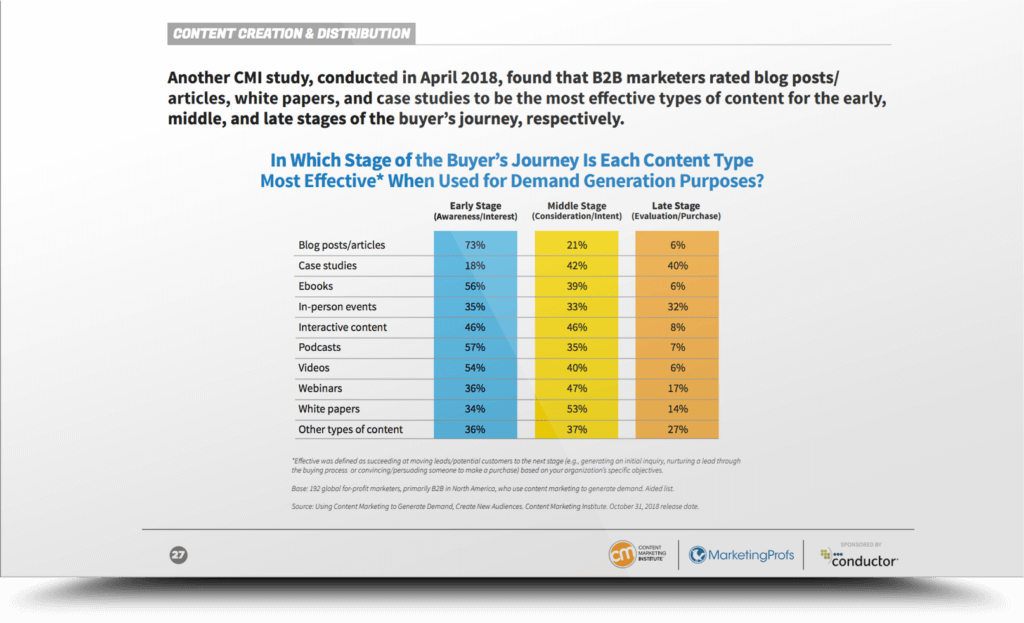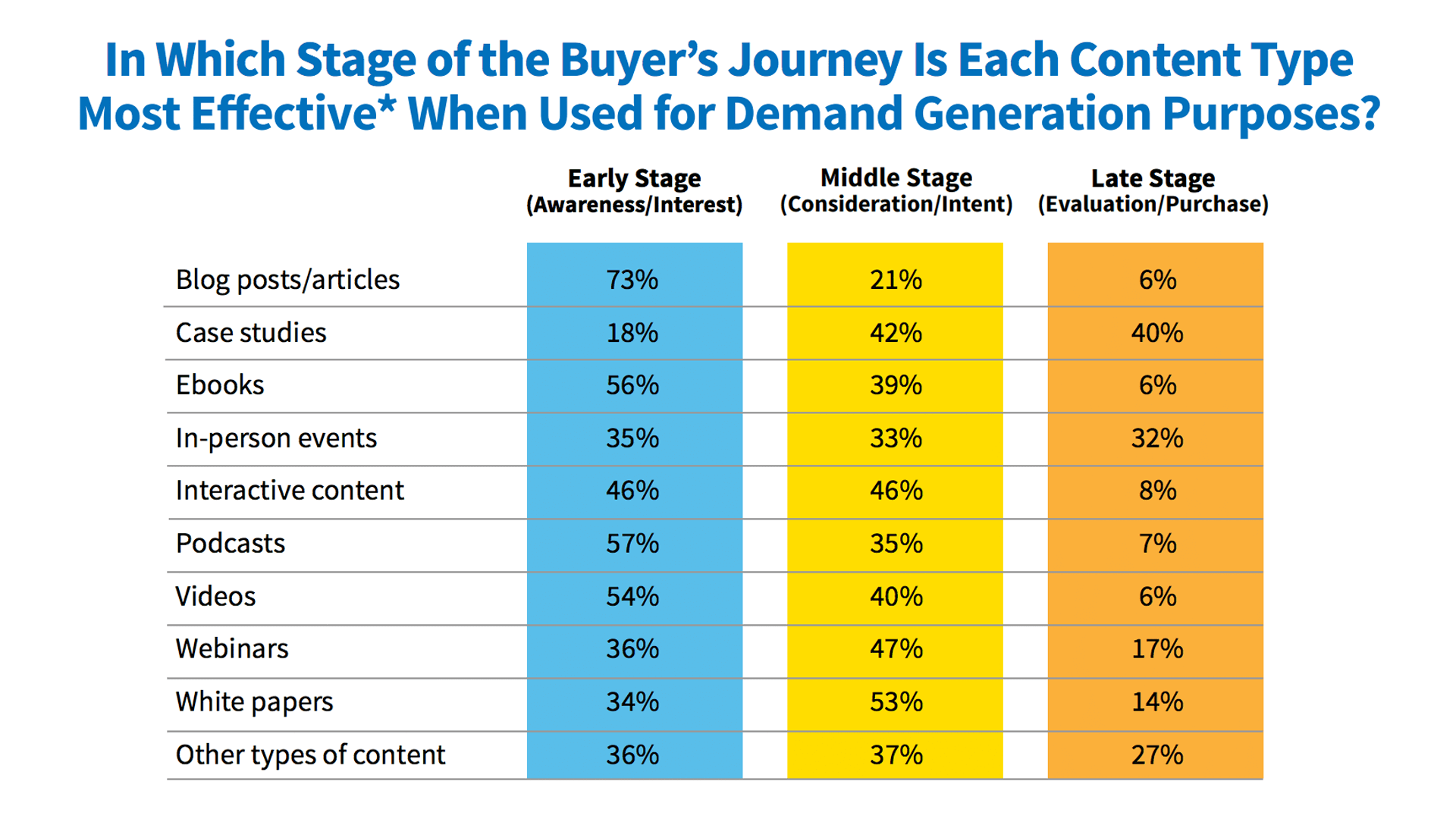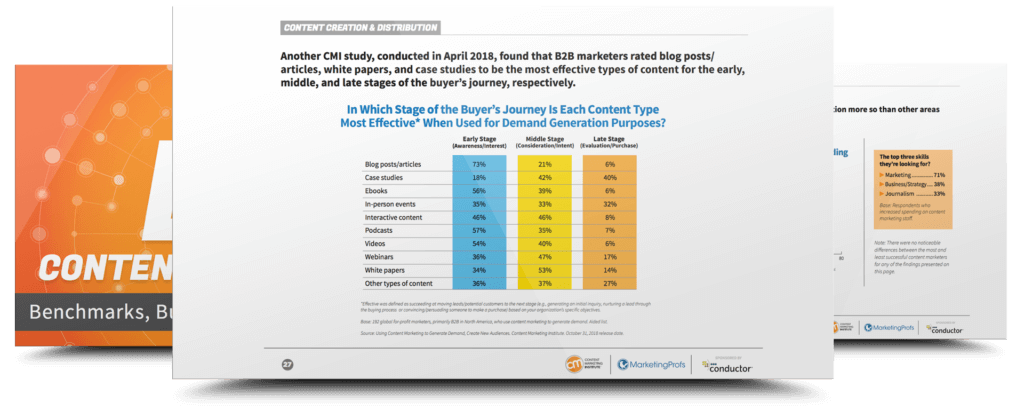
How To Procure Mind Share in Long Buying Cycles with B2B Content Marketing
Why marketing automation excels at selling to buyers on the long customer journey, and how to prepare campaigns for the long haul.
The competition for attention in the digital age is fierce, and only getting noisier by the day. As a result, too many B2B marketers are losing the battle for prospect mind share.
A recent report on content preferences by DGR shows that 78% of B2B buyers typically consume at least 3 pieces of content before engaging with a salesperson when they are making a purchase decision. Moreover, almost one in five buyers report consuming 7 pieces of content or more.
For marketing professionals, this insight makes a double-edged sword. First, it cuts through the muck to make clear that content is more important than ever in the buyer’s journey, and especially in the early and middle phases of the customer journey—the stages when content marketing matters most.
[blockquote photo=”” author=”” company=”2018 DGR CONTENT PREFERENCES SURVEY” link=”” target=”_blank”]78% of B2B buyers typically consume at least 3 pieces of content before engaging with a salesperson[/blockquote]
But it also slices open our ever increasing anxiety about getting our content seen in the first place, with buyers forever swiping through the endless feed of competitive product messaging.
In a typical B2B customer journey, when complex purchasing decisions take time, and where buying cycles consist of months of evaluation, how do you get your brand, products and services to stand out? With so many other companies vying for our audience’s time, what does it take to own a meaningful brand position in the prospect’s worldview?
Understanding the Context of the Customer Journey
Those of us who spend our workdays crafting messaging and content for our audiences can easily get carried away with the stories we invent. It’s understandable—perhaps even desirable—that marketers become engrossed with the finer details of our brands.
After all, our continued success as professional storymakers dictates that all the messaging about our products, services and offers take up an exaggerated, larger-than-life centrality in our own minds. But that being the case, it’s easy to forget that our prospects aren’t discovering our brand with the same natural understanding of the value that our solutions bring to the world.
As a result, it’s all too common that we approach messaging strategy with some bad assumptions about the context of our communications.
The Promise of Empathic Marketing Design
To combat this distortion, it’s critical we maintain an empathetic perspective when designing our marketing strategy. Whether we like it or not, it’s critical to keep in mind that our potential customers really don’t care about our brands, products and services.
Your prospects—whether they already know your brand or not—most likely spend exactly zero minutes per day thinking about your offers. Share on XLike you and I, these are real people dealing with real problems in the real world. Like us, they spend most of their time solving their problems task by task, moving the ball downfield using whatever tools and resources they can find. When they set off on the journey to find solutions to new problems, our products and services are neither the end destination nor the purpose of the story.
Of course, to be successful in the marketplace, our offers must be able to help our prospects solve their problems. But at the end of the day, in the epic narrative that is the customer’s journey, our solutions will always only play a supporting role. It’s important that we remember that the customer is the hero.
This is a critical insight because it reminds us that there are probably dozens, if not hundreds and thousands of businesses competing for our prospects’ attention. In the long buying cycle, there is a real danger that the brand and product messaging we have worked so hard to build will only occupy a few brief moments of their journey.
[blockquote photo=”” author=”” company=”” link=”” target=”_blank”]In the epic narrative that is the customer’s journey, our solutions will only play a supporting role. It’s important to always remember that the customer is the hero of the story.[/blockquote]
But if you’re doing content marketing strategy the right way and producing content that truly helps your audience solve problems and gain insights that help them do their jobs, and if you have developed an intelligent content distribution strategy that gets your content in front of the right audience at the right time, you are indeed going to earn some of those cherished, brief moments in the journey.
Assuming our content marketing program is working the way it’s supposed to, he real challenge we need to address is this: When we finally do earn our customer’s attention, how do we turn those brief moments into long term opportunities to shape the customer experience and turn their journey in our direction?
Mapping The Customer Journey
One of the most important things any marketing team can do to assure success with content marketing is to document their content marketing strategy. And one of the most important parts of any documented content marketing strategy is the Customer Journey Map.
When you are developing your content marketing strategy, journey mapping provides a framework for thinking about how your prospects and customers experience your content. Assuming you have done the hard work to develop personas, you already have deep insights about typical prospect behavior in your niche. Then assuming you have used your persona research to develop value propositions and product market fit, you have also fine tuned a messaging framework that will uniquely distinguish your offer in the marketplace. The next thing you need to figure out is which content formats are best suited to convey your messaging, and what kind of content is going to perform best for your specific audience.
Creating a customer journey map not only helps you accomplish this feat, it gives you a really strong foundation for thinking about your entire content marketing operation. When you’re mapping your customer journey, you’re engaged in an exercise that forces you to apply the knowledge you have gained about your prospects and their online behavior to plot a content strategy that anticipates their information needs and requirements at each stage of the buying cycle.
How you build your map will depend on your unique industry requirements, but in each case you will need to define a few key items. For example, how many and what kind of stages will you use to understand the customer journey? The standard model—borrowing from the classic marketing funnel—breaks down into three parts, usually defined as the early (awareness), middle (consideration) and late (decision making) stages.
Then, for each stage of your customer journey, you will need to determine the highest performing content formats for your niche audience. Every industry audience is different, so your mileage will vary, but there is lots of research that shows cross sector benchmarks. For example, a recent study from CMI suggests that blog articles, white papers and case studies are among the highest performers at different buyer journey stages.

Content Marketing Methods B2B Marketers Use to Nurture Their Audience
Email/Email Campaigns 87%
Educational Content 77%
Clear Calls-to-Action for Next Steps 62%
In-Person Events 61%
Storytelling/Relating to the Audience 45%
Offers/Incentives 27%
Community Building/Audience Participation 23%
Membership Perks 6%
Predictive Technology 5%
Other Methods 2%
A recent study published at HBR by Nicholas Toman, Cristina Gomez and Brent Adamson (co-author of the ground-shifting “Challenger Sale”) brings to light an important distinction that helps us think more clearly about the role of marketing automation in the content marketing universe.
Responsive Selling Versus Prescriptive Selling
While content marketing has evolved, primarily, as a “responsive” mode of selling—following the prospects lead, feeding their cravings for more and more content by providing as much information as possible—marketing automation returns some control of the process to the supplier, making a “prescriptive” selling paradigm much more attainable.
[blockquote photo=”” author=”” company=”Harvard Business Review” link=”https://hbr.org/2017/03/the-new-sales-imperative” target=”_blank”]Prescriptive suppliers give a clear recommendation for action backed by a specific rationale; they present a concise offering and a stable view of their capabilities.[/blockquote]
With smart marketing automation strategy, we can not only gather actionable intelligence that allows us to better anticipate our prospects’ needs, we avail ourselves a new, highly customizable communications channel that allows us to drive the sales process, expertly advising our prospects about the benefits of our offers.
Standing out among our competition while our prospects evaluate all of the consumable content in our domain is not only about making great content. Our success will also depend on our tactical proficiency, our ability to deliver the right messaging at precisely the right time. Marketing automation is the tool that makes this possible, giving us the opportunity to occupy prospect mind share throughout the buying cycle.
[blockquote photo=”” author=”” company=”Harvard Business Review” link=”https://hbr.org/2017/03/the-new-sales-imperative” target=”_blank”]Customers perceive prescriptive salespeople as being one step ahead, anticipating and eliminating obstacles. That translates directly into business results: Suppliers that make buying easy are 62% likelier than other suppliers to win a high-quality sale[/blockquote]

